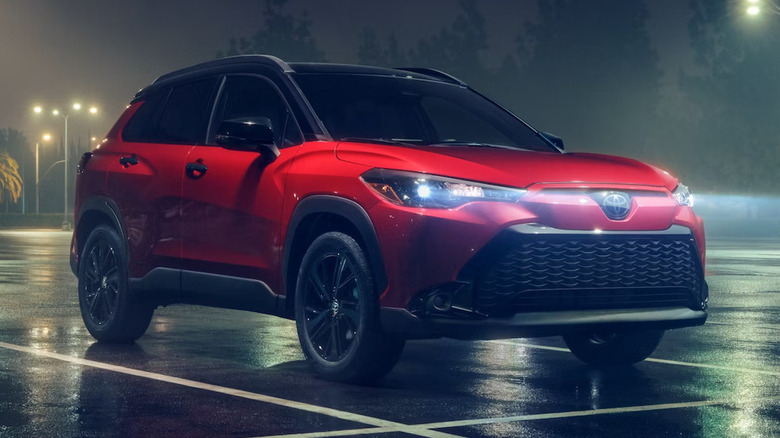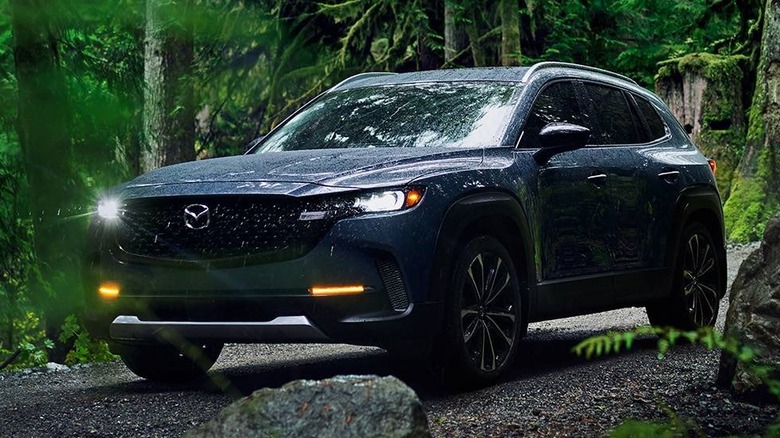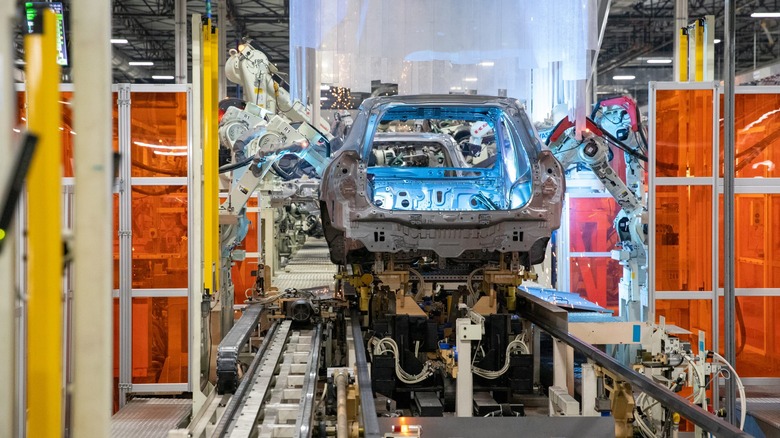The Relationship Between Toyota And Mazda Explained
It's not unusual to see acquisitions and mergers among different car manufacturers. This is especially true with companies like General Motors and Stellantis that own a vast array of different brands. Outside of creating large corporations designed to make a lot of money, what these kinds of structures set up is the ability for different automakers to utilize the same parts and facilities as their sister brands. For instance, Stellantis currently uses the 3.6L Pentastar V6 engine in vehicles made by Dodge, Jeep, Chrysler, and more, and that's completely without issue because it's all under one umbrella. Sometimes the companies go even further and essentially make the same exact vehicle, such as the Chevrolet Silverado 1500 and GMC Sierra 1500.
What is far rarer, however, is when two businesses that are not connected by a larger parent company — and are in fact direct competitors — decide to form a partnership that allows them to have that kind of crossover but remain separate entities. You might think that goes against just about everything you thought about business practices, but this is exactly what Japanese automakers Toyota and Mazda decided to do in 2018 when they formed a partnership for manufacturing. The first factory for the newly minted company, Mazda Toyota Manufacturing U.S.A., opened in 2021 in Huntsville, Alabama. Let's break down exactly what this partnership entails for the two brands and why they are able to coexist within the walls of one particular factory.
The state of Mazda
For about three decades, Mazda was able to have a major foothold in the United States car market thanks to a partnership with Ford. That linking goes all the way back to 1974, and by 1979, the Detroit automaker owned about one-quarter of Mazda on the whole. That number increased even more throughout the years to one-third ownership. Until 2008. This was the time of a massive economic downturn with a dramatic crashing of the stock market and a period known as the Great Recession. The American automotive industry was one of the industries heavily affected by this collapse, and it received a highly controversial bailout from the United States government.
Starting in 2008, Ford began selling shares of its Mazda stock, little by little each year, and by 2015, the two companies no longer had any kind of relationship. With that, Mazda was in a tough spot, as it no longer had an American partner to help it make any kind of significant headway in the country's automobile market. Sure, the Japanese company was doing perfectly fine in Japan, but the United States is such a large market for vehicles. Mazda needed some help with that, especially for producing cars within America.
The first blush of partnering with Toyota actually came a few months before Ford's divestment in 2015. Car production and keeping up with evolving technology, especially with controlling fuel emissions, is an immensely expensive prospect, so the two companies decided to start sharing technology in an effort to lower those costs across the board. That partnership would only deepen as it relates to the United States.
Home of the Corolla Cross and CX-50
Sharing technology is one thing, but sharing an actual physical space where vehicles are manufactured is another. This is where the formation of Mazda Toyota Manufacturing U.S.A. comes into play. Another way companies can cut production costs is by consolidating manufacturing space. The newly formed business had to start out with a major opening bid, and it invested $1.6 billion — which would end up being $2.311 billion by the end — into building a new car manufacturing plant in Huntsville, Alabama. Toyota had already opened an engine factory in the town in 2001, so it makes sense why the pair would open another there to build the actual vehicles.
This new plant started off producing the Toyota Corolla Cross compact crossover SUV in September 2021, and in January the following year, production started on the Mazda CX-50, the company's own compact crossover SUV. Although they're similar vehicles, they don't necessarily share the same parts. For instance, the Toyota utilizes a 2.0L I4 engine as its standard option, whereas the Mazda has the slightly larger 2.5L Skyactiv-G I4 under the hood.
Each vehicle gets its own designated assembly line — Apollo for the Corolla Cross, and Discovery for the CX-50. Neither model gets prioritized over the other, resulting in the exact same number produced for each. If nothing else, that demonstrates Toyota and Mazda being able to engage in a true 50-50 partnership. So far, this is the only factory that the Mazda Toyota Manufacturing U.S.A. company operates, but as the business relationship continues, who knows what else could happen.


